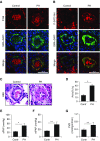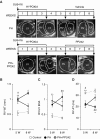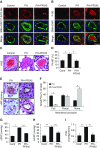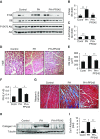Pharmacological Inhibition of mTOR Kinase Reverses Right Ventricle Remodeling and Improves Right Ventricle Structure and Function in Rats
- PMID: 28679058
- PMCID: PMC5705904
- DOI: 10.1165/rcmb.2016-0364OC
Pharmacological Inhibition of mTOR Kinase Reverses Right Ventricle Remodeling and Improves Right Ventricle Structure and Function in Rats
Abstract
Pulmonary arterial hypertension (PAH) is characterized by pulmonary vascular remodeling, increased pulmonary artery (PA) pressure, right-heart afterload and death. Mechanistic target of rapamycin (mTOR) promotes smooth muscle cell proliferation, survival, and pulmonary vascular remodeling via two functionally distinct mTOR complexes (mTORCs)-1 (supports cell growth) and -2 (promotes cell survival), and dual mTORC1/mTORC2 inhibition selectively induces pulmonary arterial hypertension PA vascular smooth muscle cell apoptosis and reverses pulmonary vascular remodeling. The consequences of mTOR inhibition on right ventricle (RV) morphology and function are not known. Using SU5416/hypoxia rat model of pulmonary hypertension (PH), we report that, in contrast to activation of both mTORC1 and mTORC2 pathways in small remodeled PAs, RV tissues had predominant up-regulation of mTORC1 signaling accompanied by cardiomyocyte and RV hypertrophy, increased RV wall thickness, RV/left ventricle end-diastolic area ratio, RV contractility and afterload (arterial elastance), and shorter RV acceleration time compared with controls. Treatment with mTOR kinase inhibitor, PP242, at Weeks 6-8 after PH induction suppressed both mTORC1 and mTORC2 in small PAs, but only mTORC1 signaling in RV, preserving basal mTORC2-Akt levels. Vehicle-treated rats showed further PH and RV worsening and profound RV fibrosis. PP242 reversed pulmonary vascular remodeling and prevented neointimal occlusion of small PAs, significantly reduced PA pressure and pulmonary vascular resistance, reversed cardiomyocyte hypertrophy and RV remodeling, improved max RV contractility, arterial elastance, and RV acceleration time, and prevented development of RV fibrosis. Collectively, these data show a predominant role of mTORC1 versus mTORC2 in RV pathology, and suggest potential attractiveness of mTOR inhibition to simultaneously target pulmonary vascular remodeling and RV dysfunction in established PH.
Keywords: mechanistic target of rapamycin complex 1; mechanistic target of rapamycin complex 2; mechanistic target of rapamycin kinase inhibitor; pulmonary hypertension; right ventricle.
Figures







Similar articles
-
Mammalian target of rapamycin complex 2 (mTORC2) coordinates pulmonary artery smooth muscle cell metabolism, proliferation, and survival in pulmonary arterial hypertension.Circulation. 2014 Feb 25;129(8):864-74. doi: 10.1161/CIRCULATIONAHA.113.004581. Epub 2013 Nov 22. Circulation. 2014. PMID: 24270265 Free PMC article.
-
PAI-1 deficiency drives pulmonary vascular smooth muscle remodeling and pulmonary hypertension.Am J Physiol Lung Cell Mol Physiol. 2024 Sep 1;327(3):L319-L326. doi: 10.1152/ajplung.00110.2024. Epub 2024 Jun 11. Am J Physiol Lung Cell Mol Physiol. 2024. PMID: 38860847
-
Natural reversal of pulmonary vascular remodeling and right ventricular remodeling in SU5416/hypoxia-treated Sprague-Dawley rats.PLoS One. 2017 Aug 15;12(8):e0182551. doi: 10.1371/journal.pone.0182551. eCollection 2017. PLoS One. 2017. PMID: 28809956 Free PMC article.
-
Epigenetic Regulation of Pulmonary Arterial Hypertension-Induced Vascular and Right Ventricular Remodeling: New Opportunities?Int J Mol Sci. 2020 Nov 24;21(23):8901. doi: 10.3390/ijms21238901. Int J Mol Sci. 2020. PMID: 33255338 Free PMC article. Review.
-
mTOR and vascular remodeling in lung diseases: current challenges and therapeutic prospects.FASEB J. 2013 May;27(5):1796-807. doi: 10.1096/fj.12-222224. Epub 2013 Jan 25. FASEB J. 2013. PMID: 23355268 Free PMC article. Review.
Cited by
-
mTOR Signaling in Pulmonary Vascular Disease: Pathogenic Role and Therapeutic Target.Int J Mol Sci. 2021 Feb 21;22(4):2144. doi: 10.3390/ijms22042144. Int J Mol Sci. 2021. PMID: 33670032 Free PMC article. Review.
-
Alpha-enolase regulates the malignant phenotype of pulmonary artery smooth muscle cells via the AMPK-Akt pathway.Nat Commun. 2018 Sep 21;9(1):3850. doi: 10.1038/s41467-018-06376-x. Nat Commun. 2018. PMID: 30242159 Free PMC article.
-
Differential effects of integrin-linked kinase inhibitor Cpd22 on severe pulmonary hypertension in male and female rats.Pulm Circ. 2020 Feb 12;10(1):2045894019898593. doi: 10.1177/2045894019898593. eCollection 2020 Jan-Mar. Pulm Circ. 2020. PMID: 32110386 Free PMC article.
-
Focus on Early Events: Pathogenesis of Pulmonary Arterial Hypertension Development.Antioxid Redox Signal. 2019 Nov 1;31(13):933-953. doi: 10.1089/ars.2018.7673. Epub 2019 Jul 2. Antioxid Redox Signal. 2019. PMID: 31169021 Free PMC article. Review.
-
Pulmonary Hypertension and Right Ventricle: A Pathophysiological Insight.Clin Med Insights Cardiol. 2024 Sep 9;18:11795468241274744. doi: 10.1177/11795468241274744. eCollection 2024. Clin Med Insights Cardiol. 2024. PMID: 39257563 Free PMC article. Review.
References
-
- Humbert M, Morrell NW, Archer SL, Stenmark KR, MacLean MR, Lang IM, Christman BW, Weir EK, Eickelberg O, Voelkel NF, et al. Cellular and molecular pathobiology of pulmonary arterial hypertension. J Am Coll Cardiol. 2004;43(12) suppl S:13S–24S. - PubMed
-
- Yeh ETH, Tong AT, Lenihan DJ, Yusuf SW, Swafford J, Champion C, Durand J-B, Gibbs H, Zafarmand AA, Ewer MS. Cardiovascular complications of cancer therapy: diagnosis, pathogenesis, and management. Circulation. 2004;109:3122–3131. - PubMed
MeSH terms
Substances
Grants and funding
LinkOut - more resources
Full Text Sources
Other Literature Sources
Miscellaneous

